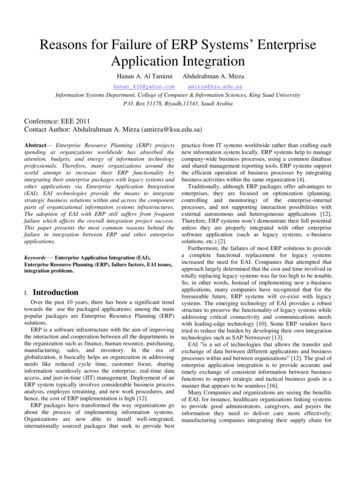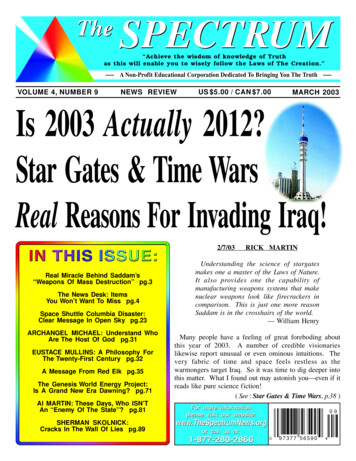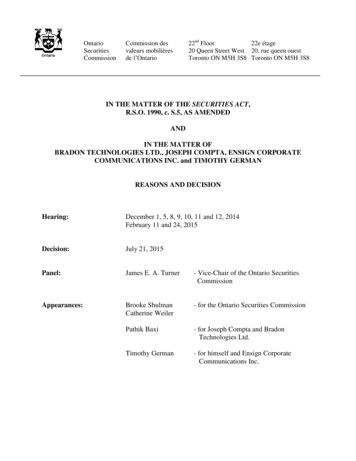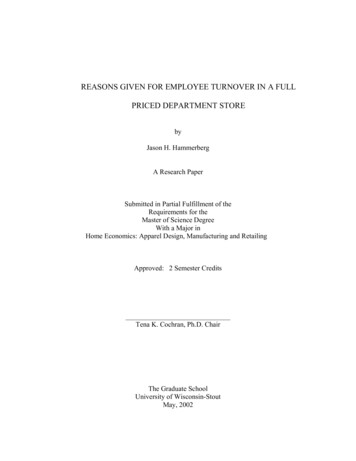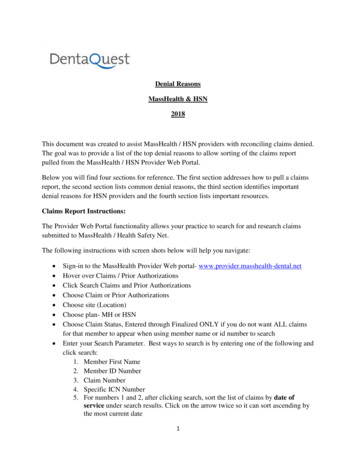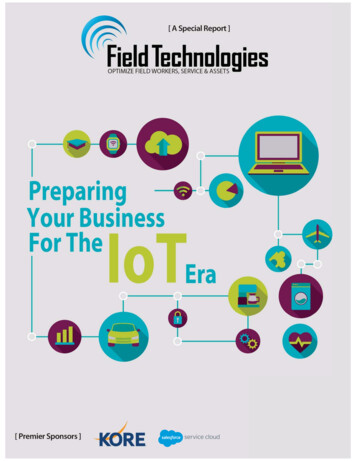
Transcription
From The Editor3 Reasons The Time For IoT Is NowIf you haven’t already, it’s time to jump on theInternet of Things (IoT) bandwagon. If you’vebeen sitting back waiting to better understand thetechnology and its role in your operation, you nowneed to take action. IoT technology isarguably THE biggest thing happeningin field service right now, and here arethree reasons you need to be putting itto work for you.#1: The Writing Is On The WallIs IoT a fad? No. Does it have a placein field service? Yes. Are other companies using it to their advantage?Yes. The writing is on the wall whenSarah Nicastroit comes to IoT — just take a lookpublisher/at some of the statistics. Cisco estieditor in chiefmates that the number of connectField Technologiesed devices worldwide will rise tosarah.nicastro@50 billion by 2020. Gartner reportsfieldtechinfo.comthat by 2020, 25 billion “things”will be connected. General Electricestimates that the “Industrial Internet” market,which refers to connected industrial machinery,will add 10 to 15 trillion to the global GDPwithin the next 20 years. And McKinsey GlobalInstitute estimates the potential impact from IoTapplications on the productivity of field employees at 19 billion to 43 billion in 2025. IoT isn’tjust another buzzword that’s going to fade away;it’s the future of the field service industry.#2: It Solves Your Biggest ProblemsField service has shifted to be far more customer-focused in recent times, and IoT can helpyou achieve many of your objectives relatedto improving customer service and experience(along with efficiency gains and cost savings). Arecent report from Aberdeen Group, Field Service2016: Strengthen the Team and Bond with YourCustomers, examined the top pressures demand-Special Report: Preparing Your Business For The IoT Era ing service evolution. Fifty percent of respondentscited changing customer dynamics; 42 percentreported increasing competition in service; 41percent mentioned the need to improve customerengagement; 32 percent pointed to increasingproduct-based competition; and 31 percent spokeof reduced service margins. These top pressurescan all be lessened by leveraging IoT solutions.#3: Hesitating Will Make You A LaggardVanson Bourne recently reported that when itcomes to IoT, many companies still have reservations. Their report found that 88 percent of companies said there are challenges with connecteddevices, and 30 percent didn’t believe sensorscould replace human insight and instincts. Whilethese concerns may be valid, they aren’t a reasonto ignore the role IoT can play in your organization. There are always challenges with technology — most all of them are able to be overcome.And I agree that sensors can’t replace humaninsight. In my opinion, they aren’t meant to; theyare meant to serve as tools for your techniciansand your company, which allow you to operatemore effectively and efficiently. The reality is, letting your concerns, confusion, or desire to stickwith the status quo prevent you from incorporating IoT into your business will cause you to fallbehind your competition. Many service companiesare already successfully leveraging IoT and transforming their businesses as a result. If you don’twork toward doing the same, you are at risk ofbecoming a laggard — and that’s something yourcustomers are sure to notice.Field Technologies magazine FieldTechnologiesOnline.com
Technology EssentialsStep One: Understand TheTechnology EssentialsIoT isn’t a singular technology, but a concept born out ofthe convergence of a number of different technologies.For a company to utilize IoT for service, maintenance, orsupport applications, it must first have a number of different technology pieces in place and be able to link serviceable assets to the internet.That last capability is often the biggest hurdle companiesface when planning to join IoT. According to AberdeenGroup, even top-performing companies are only connecting half of all serviceable equipment to IoT for maintenance,tracking, and service. For other companies, that number isjust one-third of equipment.A PTC/Servicemax survey found that 42 percent of servicecompanies believed they had a product that was suitablefor sensor-based monitoring, while 26 percent weren’tsure, and 23 percent said their products were not suitablefor such monitoring. In some cases, equipment is alreadyon the network — a lot of laboratory test equipment orindustrial machinery, for example, is already hard-wired intocompany networks. In other cases, wireless technology canbe used to retrofit assets. Some assets, however, will have tobe fundamentally redesigned in order to support networkability and the use of sensors. Depending on the length ofthe product design cycle, it could be several years beforesome classes of assets can be linked to IoT.Once you get past the asset itself, there are several othertechnologies that companies may need to have in place inorder to use IoT for service applications.Sensors: To enable remote service and troubleshooting, companies will need access to a number of differentdata points. This will vary depending on the application,but temperature, shock/vibration, motion, moisture, andother types of sensors will provide important informationrequired for diagnosing and fixing problems remotely.RFID: High-memory RFID tags can identify assets andstore data on maintenance/service events. Integrating thesetags with sensors provides important service data that canbe accessed on-site or remotely.Remote Monitoring: In order to provide remote service, you have to be able to access the equipment fromoutside of your customer’s own firewall. In existing M2MSpecial Report: Preparing Your Business For The IoT Era service applications, this is accomplished either by providing network access to the service provider or by usinga separate, cellular-based point of contact for the asset.Either method will require you to ensure the securityof data transactions. It’s also important to evaluate thepotential costs of moving data from thousands of assetsacross the cellular network.Big Data And Analytics: IoT can provide a torrent of data.You should evaluate ahead of time what data is most usefulin order to limit the amount of data you collect and store.That data will take many forms, some of it structured, someof it not. Big Data and analytics software tools will help youturn that flood of data into actionable information.The Cloud: To that end, many companies are unlikely tohave the storage capacity or computing resources to storeand analyze potentially very large data sets. Cloud-basedstorage and analytics applications can help ease the burdenof maintaining those resources while providing the ability toscale-up as your use of IoT expands.The cloud also eases infrastructure requirements, not justin server investments, but also in bandwidth. If continuousstreams of data have to be collected, it’s better for them tohit the cloud server first; that way, your own internal networks and broadband connections aren’t bogged down bythe increased traffic.Security: Every connected device offers a potential pointof access for hackers or malware attacks. Your approach tosecurity (including encryption and authentication) shouldtake into account the vulnerability of the remote assets andtheir likely limited support for onboard security support.Customers may also want more control over what data iscommunicated and how often.Dynamic Scheduling And Dispatching Tools: Once youare able to receive real-time alerts about potential serviceissues from the assets themselves, your scheduling capabilities have to be agile enough to respond. In some installations, alerts from connected equipment can automaticallygenerate work orders in a field service management systemand dispatch them to the correct technician. That willrequire a high level of flexibility and intelligence from thescheduling/dispatch engine.Field Technologies magazine FieldTechnologiesOnline.com
IoT DataStep Two: Put IoT Data To WorkThe value of IoT isn’t the technology itself, but the information that the technology can provide. Analyzing and usingthat data creatively and finding ways to manage terabytes ofinformation will be an ongoing challenge. Once you are ableto separate the signal from the noise, there are a number of waysto leverage connected device data to improve the business process.The benefits can provide a significant pay-off. According to datafrom The Service Council, using IoT in service can improve remoteresolution rates by 41 percent, boost first-time fix rates by 11 percent, increase asset uptime, and reduce mean-time-to-repair by 9percent. To achieve those types of results, companies should bedeliberate about the data they collect, identify potential value opportunities that exist from collecting that data, and then configure theirproducts/assets accordingly to provide the data they need.How IoT Can Help You Lower CostsThere are a number of ways to put this data to work that can positively affect both the top and bottom lines. The first is by using IoTdata to lower costs and increase profits. Having remote, real-timeaccess to asset/product performance data allows service organizations to get in front of maintenance issues before they turn intofailures. If you are able to remotely access and repair equipment(i.e., via a software/firmware update or by remotely adjusting orand reducing costs, service organizations will improve customerloyalty. In an increasingly competitive market, the ability to add valuebeyond simply completing a repair will make it harder for othercompanies to poach your customers, even if they offer up-front costsavings. Customers value the ability of a service company to provideproactive or remote service because it ultimately improves their ownoperations and reduces costs both through avoiding more expensive repairs and reducing costly equipment downtime.Service companies can also use IoT to increase revenue by offering new, value-added services at a premium. With remote access toproducts/assets, you can create new service packages or service contract tiers based on responsiveness or even access to performancedata. For example, ATEK Access Technologies, which providesindustrial sensing and monitoring of fuel storage tanks, deployed aremote monitoring solution that includes sensors on the tanks viaa cloud-based solution that allows ATEK to offer these monitoringservices to its customers while making it easier to ensure that thetank sensors are working correctly.The IoT data is inserted into business processes within Salesforceand generates alerts based on predefined operational parameters.Uptime has increased, and customers can use the information toimprove their own fuel truck scheduling. ATEK also offers differenttiers of intelligence with its service packages, available at a premium.For manufacturers thatservice their own products,IoT also offers a previouslyunavailable window intoreal-world performance thatcan improve product development.The availability of real-timeproduct performance information from the field addsThe Service Councila new dimension to productquality and the design process. Insight into how products are performing and how customers are actually using them canbe fed to the engineering and design teams to help improve futureiterations of those same products or to help guide them in creatingnew products. Developers of product data management (PDM) andproduct lifecycle management (PLM) are just beginning to explorehow IoT data can be incorporated into their solutions and thenlinked back to quality and computer-aided design (CAD) systems.The top three PLM vendors (PTC, Dassault Systemes, and SiemensPLM Software) have all made aggressive moves into the IoT space.IoT creates a real-time, integrated link between service and product development that in the past was fragmented for most companies, if it existed at all.Using IoT in service can improve remoteresolution rates by 41 percent, [and] boost firsttime fix rates by 11 percent.recalibrating a device), you can save a costly truck roll — savings thatcan amount to several thousand dollars per incident, depending onthe industry.If a technician visit is required, IoT data can help ensure the righttechnician arrives with the right skillset, parts, and repair informationto successfully complete the job on the first visit. This can eliminatehours of wasted time and labor, as well as costs associated withobtaining and returning incorrect parts. Organizations can simultaneously reduce the cost of completing each work order while making technicians more productive. The company can then providemore service with fewer resources and at a lower cost.By providing more timely service, increasing first-time fix rates,Special Report: Preparing Your Business For The IoT Era Field Technologies magazine FieldTechnologiesOnline.com
Connecting PeopleStep Three: Connect People To IoTUsing IoT in the service sector won’t just require new technology; it will also require new skills and capabilities. IoTdoesn’t just automate service processes and activities, itchanges the way service is delivered in a fundamental wayand in some cases creates all new processes.The proactive service approach enabled by IoT is still very foreignto many service organizations. A survey sponsored by PTC andServicemax found that 44 percent of field service organizations werestill largely reactive when it came to customer service, while a thirdwere taking a mixed approach of proactive and reactive service.Employees need to transition to an environment in which they areexpected to react in real time to conditions. Scheduled maintenancewill give way to usage-based service. Daily schedules may becomemore dynamic.Make sure that technicians, dispatchers, managers, and otheremployees are involved in the process as early as possible, so thateveryone knows why the new technology is being deployed, how itwill benefit customers and employees, and what cha
but temperature, shock/vibration, motion, moisture, and other types of sensors will provide important information required for diagnosing and fixing problems remotely. RFID: High-memory RFID tags can identify assets and store data on maintenance/service events. Integrating these tags with sensors provides important service data that can be accessed on-site or remotely. Remote
